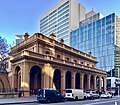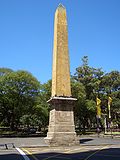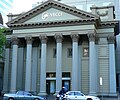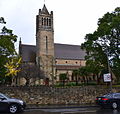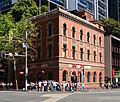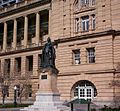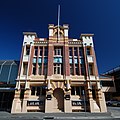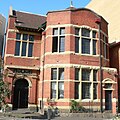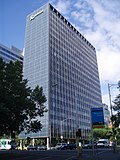This article needs additional citations for verification .(September 2020) |
Australian non-residential architectural styles are a set of Australian architectural styles that apply to buildings used for purposes other than residence and have been around only since the first colonial government buildings of early European settlement of Australia in 1788.
Contents
- Old Colonial Period (1788–c. 1840)
- Old Colonial Georgian
- Old Colonial Regency
- Early Colonial Classical
- Early Colonial Gothic Picturesque
- Victorian period (c. 1840–c. 1890)
- Victorian Georgian
- Victorian Regency
- Victorian Egyptian
- Victorian Academic Classical
- Victorian Free Classical
- Victorian Filigree
- Victorian Mannerist
- Victorian Second Empire
- Victorian Italianate
- Victorian Romanesque
- Victorian Renaissance Revival
- Victorian Byzantine
- Victorian Academic Gothic
- Victorian Free Gothic
- Victorian Tudor (Jacobethan)
- Victorian Rustic Gothic
- Victorian Carpenter Gothic
- Edwardian period (c. 1890s–1910)
- Edwardian Baroque
- Federation period (c. 1890–c. 1915)
- Federation Academic Classical
- Federation Free Classical
- Federation Second Empire
- Federation Filigree
- Federation Anglo-Dutch
- Federation Romanesque
- Federation Gothic
- Federation Warehouse
- Federation Queen Anne
- Federation Free Style
- Federation Arts and Crafts
- Federation Bungalow
- Inter-War period (c. 1915–c. 1940)
- Inter-war Georgian Revival
- Inter-war Beaux Arts
- Inter-war Stripped Classical
- Inter-war Commercial Palazzo
- Inter-war Mediterranean
- Inter-War Spanish Mission
- Inter-war Art Deco
- Skyscraper Gothic
- Inter-war Chicagoesque
- Inter-war Functionalist & Moderne
- Interwar Gothic
- Inter-war Old English (20th Century Tudorbethan)
- Inter-War Functionalist & Moderne 2
- Post-War Period (c. 1940–1960)
- Ecclesiastical
- International Style
- Modern
- Late Twentieth-Century Period 1960–2000
- Stripped Classical
- International
- Organic
- Brutalist
- Structuralist
- Late Modern
- Post Modern
- Deconstructivist
- Immigrant's Nostalgic
- 21st-century architecture
- Deconstructivist 2
- Post Modern 2
- Structuralist 2
- Sustainable
- Green building
- Modern 2
- See also
- References
- Bibliography
- External links
Their distribution follows closely the establishment and growth of the different colonies of Australia, in that the earliest colonial buildings can be found in New South Wales and Tasmania.
The classifications set out below are derived from a leading Australian text. [1]









